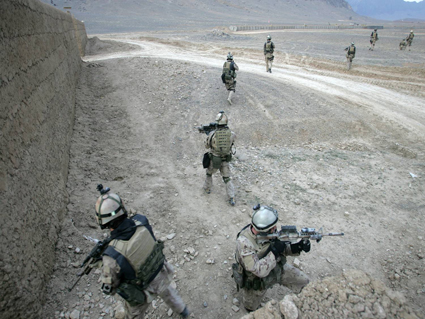Article / February 2, 2016
On February 1, 2016, the Canadian Special Operations Forces Command (CANSOFCOM) celebrated its tenth anniversary.
In 2005, General Rick Hillier, the Chief of the Defence Staff (CDS) asserted that “We need an integrated Canadian Forces that consists of maritime, air, land and special forces, woven together to make a more effective military.” Subsequently, he declared that he intended “on bringing JTF 2, along with all the enablers that it would need, to conduct operations successfully into one organization with one commander.” As result, on 1 February 2006, the CDS created CANSOFCOM as part of his larger transformation initiative. The Command included a headquarters, JTF 2, the Canadian Joint Incident Response Unit (CJIRU), the Canadian Special Operations Regiment (CSOR), and 427 Special Operations Aviation Squadron (SOAS).
 |
| CSOR Operators on Patrol in Afghanistan (Undated Photo DND) |
Ten years into its existence, CANSOFCOM has proven itself as an integral national capability. It has conducted operations domestically and around the world, particularly in combat theatres and countries at risk. Throughout the past decade its members have demonstrated a high level of professionalism and expertise. Importantly, the Command has provided DND and the Government of Canada with a unique capability that is unmatched elsewhere in the Canadian Armed Forces or any other governmental department.
Canada’s history with special operations goes back to its beginnings as a French colony. Specifically, Canada’s SOF traditions can be traced back to la petite guerre conducted by the French-Canadian raiders during the struggle for colonial North America. Their daring and aggressive raids allowed the embryonic nation to punch above its weight in the battle for North America.
This tradition created a legacy that lives on to this day in the nation’s SOF forces. It was next resurrected in the Second World War as Canadians wrote a new chapter of national SOF history. Canadian participation in the British Special Operations Executive, responsible for sabotage and subversion in Occupied Europe, was the earliest example. Canada also created the Viking Force, its own version of the famous British Commandos, as well as the Royal Canadian Navy Beach Commando “W.” In addition, the 1st Canadian Parachute Battalion, which boasted a 30 percent selection rate, as well as the Canadian component of the First Special Service Force, also known as the “Black Devils,” were stood up. Notably, all contributed to a proud national record in the conduct of special operations.
The special operations mandate in the post-war era fell to the Canadian Special Air Service Company, which existed between 1948 to 1949 and then to the Canadian Airborne Regiment (Cdn AB Regt), which spanned from 1968 to 1995. The Cdn AB Regt’s mandate was to deploy into an operational theatre within 48 hours to provide “a force capable of moving quickly to meet any unexpected enemy threat or other commitment of the Canadian Armed Forces,” as well as “special forces types of tasks.”
In was not until the mid-1990s, however, that Canada’s modern SOF capability began to truly take shape. On 1 April 1993, the Department of National Defence (DND) took over the national hostage rescue / counter-terrorism responsibility when it created Joint Task Force Two (JTF 2) to replace the Royal Canadian Mounted Police Special Emergency Task Force (SERT).
The deployment of a JTF 2 special operations task force to Afghanistan in the aftermath of the 11 September 2001 (9/11) terrorist attack in New York became a turning point for the unit, and for Canadian SOF at large. Much like many of its predecessors, JTF 2 carved its reputation in combat and earned its recognition internationally as a Tier 1 SOF unit. Continued combat duty in Afghanistan from 2005 to cessation of Canadian combat operations in 2011 simply reinforced its international credibility.
No comments:
Post a Comment